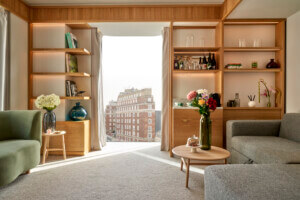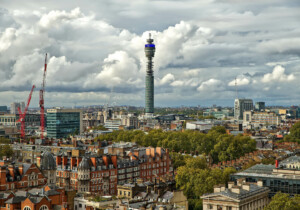“The worst building amongst a swathe of mediocrity,” read one. A “grotesque Jenga game of rabid, rectilinear blocks without the promise of collapse,” read another. Compliments for BUJ Architects’ Lincoln Plaza have been hard to come by. Today, the collection of housing units in east London’s Docklands was dealt a hammer blow in being crowned the winner of this year’s Carbuncle Cup, British architecture’s least-wanted design award.
Comprising two towers of dwellings with a cylindrical hotel mixed into the program, the ill-fated development has been the subject of severe scorn for the 2016 iteration of Building Design’s (BD) Carbuncle Cup awards. It is the fifth London building in a row to claim the trophy in the awards’ tenth successive year. Lincoln Plaza was selected from a shortlist of six projects built in the UK, three of which were in London. Last year, Rafael Viñoly’s car-melting 20 Fenchurch Sreet (a.k.a. The Walkie-Talkie Tower) took the prize.
“When you look at the crazy patterns, pick and mix colors and gimmicky balconies you can see that it lacks poise, foundation or clarity of vision,” lamented Julian Robinson of the awarding jury. “Its neighbors aren’t great but this is just an unmitigated mess.” Meanwhile, BD editor Thomas Lane was equally critical. “This is the worst building amongst a swathe of mediocrity,” he said. “South Quay is rapidly turning into London’s Carbuncle Cluster.”
The derision didn’t end there either. One reader even went so far as to say that the building’s balconies “are an open invitation to commit suicide.” Critic and member of the jury panel Ike Ijeh described Lincoln Plaza further: “31 stories of bilious cladding are piled one on top of the other to create an assortment of haphazardly assembled facades that are crude, jarring and shambolic.” He went on to add:
Essentially, this building is the architectural embodiment of sea sickness, waves of nausea frozen in sheaths of glass and colored aluminum that, when stared at for too long, summon queasiness, discomfort and, if you’re really unlucky, a reappearance of lunch as inevitably as puddles after a rainstorm.
Incidentally, the much-maligned flats in question range from $1 million to $1.2 million. The developers behind the project, Galliard Homes, describe it as a “striking new landmark against Canary Wharf’s dazzling architecture.” They go on to add: “Offering breathtaking views, first class facilities, and superlative living accommodation in a location of international status, Lincoln Plaza is set to provide one of the most prestigious and sophisticated new landmarks on Canary Wharf’s iconic skyline.”
Ijeh, though, was not impressed with this description.
Were anyone in any doubt as to the sheer level delusion and gall that has gripped London’s luxury housing market, then this asinine quotation should settle the matter once and for all. Lincoln Plaza is actually in South Quay and not Canary Wharf but what better way of showing contempt for your local context than by insinuating it is actually located in your flashier neighboring district that is more likely to be familiar to your target Malaysian investors?
But, of course, this development does not show contextual contempt by words but by actions and it is these architectural actions and not the aforementioned “views” that are truly “breath-taking.” Lincoln Plaza is a putrid, pugilistic horror show that should never have been built. In its bilious cladding, chaotic form, adhesive balconies and frenzied facades, it exhibits the absolute worst in shambolic architectural design and cheap visual gimmickry.
The only thing “sophisticated” about this scheme is the sheer level of artistry that must have been orchestrated in order to convince the local authority to award permission.
Paul Finch, editorial director of the Architects’ Journal—a rival to the publication that runs the not-so-coveted trophy—called for the competition to be ended last month. He also wrongly predicted, as did many, that:
Those who control the [Carbuncle Cup] seem to know next to nothing about commercial architecture, hate it, campaign against it and only keep quiet when a self-evidently ‘good’ architect, like Eric Parry, wins a commission to design the tallest tower in the City of London, demolishing the rather good [Aviva] tower in the process.
The predictable tone of the [Carbuncle Cup] nominations is echoed by the predictability of the results. The judges don’t get out much, so the focus is generally on London. If you can attack a big name, all the better, hence the ludicrous abuse poured on the Cutty Sark project by Grimshaw. Commercial uses are a red rag to a bull, hence the campaign against another ‘winner’, the Tesco store with apartments above at Woolwich, a brave and successful attempt to revive a benighted town centre, which I supported while sitting on the design review panel which assessed the plan…
My real objection to the [Cup] is that it is the product of mental idleness rather than genuine thought about the way in which architecture both absorbs and reflects culture, economics, fashion and the myriad other elements which inform the way we now live, work and play.
Catherine Slessor, also writing in the same publication, however, made the case for the Carbuncle Cup:
Some might regard it as a cheap exercise in tabloid trolling that takes no account of the complexities and contradictions of the design process, in which architects are merely hapless pawns, buffeted by bad clients, bad briefs and bad legislation. Yet who could argue against the guilty pleasure of witnessing the pomposity of the great and the good being pricked or the hubris of provincial nonentities witheringly exposed? After all, these purveyors of ordure are paid for what they do. And, unlike genuine ordure, bad buildings cannot be swept away.










